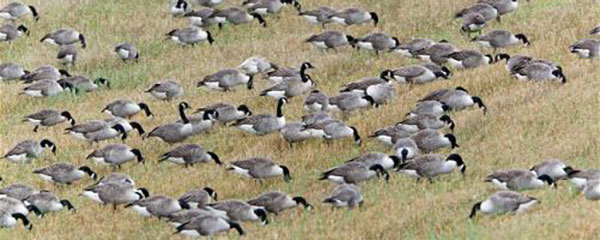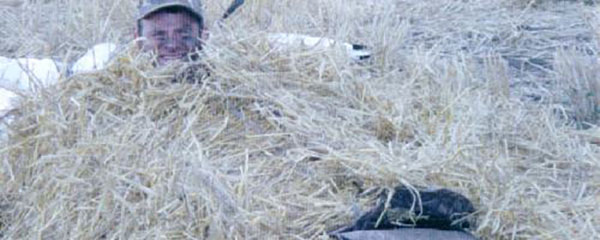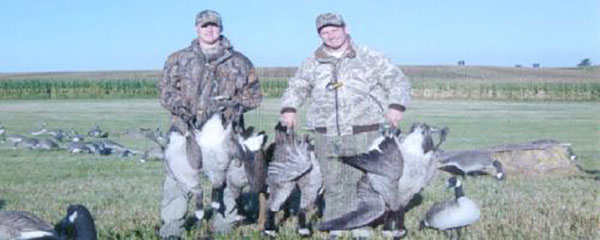Decoying Canada Geese
Decoying Canada Geese
By B.C. Maxima

A Five Part Mini-Series
- Overview: What It Takes To Be Successful
- Location: Finding the Perfect Field
- Concealment: Get Down And Cover Up
- Decoys and Calling: The Hard Facts
- The Hunt: Tying It Together
Part 1 A Brief Overview: What it takes to be successful
Burruck Burruck…Bucka Bucka Bucka…RrrrRrrrRrrrRrrr…The sight of a Dozen Moster Honkers dropping in your lap is second to none!
Throughout the past twenty years the strategies for decoying the all mighty Canada Honker have changed dramatically. Back in the 1980’s hiding in fence rows with a dozen home made decoys was considered hunting. Now there are custom full body decoys on the market that range from $25.00 a piece all the way up to $900.00 a dozen. Many hunters are left wondering what it takes to hunt geese these days. In my opinion there are three consistencies that will make your hunt successful. They are; Location, Concealment and Decoys/Calling- all equally important. Through the next 4 months we will be taking an in depth look into each area to give you a better idea of what it takes to successfully hunt Canada Geese day in and day out. For those of you who have hunted Snow Geese through the years, you have seen how they have evolved into a very smart and wary bird which have become nearly impossible to kill on certain days, no matter what your spread looks like. I am noticing that the Canada Honker is following in the same footsteps!
LOCATION

Location is key for more than one reason. First of all if there are no birds in the area that you are hunting than obviously your chances are slim to none that you will be successful. So it will be very important to do your homework and thoroughly scout your area beforehand. Ideally we are looking for a field that has had birds feeding in it consistently prior to the hunt. It is just as important to try and set up in the exact spot that the birds have been sitting in the day prior to the hunt.
And finally, we would like to be the only hunters with permission to hunt that particular spot during the hunt. Next month we will do an in depth study on: how to scout, picking the perfect field, how to attain permission on that field and keeping permission locked up for the future.
CONCEALMENT

How well you are concealed while you are hunting is just as important as your location because it gets very frustrating watching hundreds of geese coming in with there wings set at 60 yards and then flare off because they see something or someone they don’t like. The technology available in this area of the hunt has expanded immensely over the last 10 years. The field ground blind has made a huge impact on the way we hunt geese today and I think we can all agree that the company Final Approach has pioneered this technology.
Each year it seems that there is a better product on the market and I firmly believe that this is one aspect that you do not want to skimp on. In the July article we will be covering “Concealment” in great detail including: an examination of the different options available, an indepth comparison of the current ground blinds on the market today and what types of blinds work best in different situations. Just remember this, if there are 4 hunters in a field and only three of them are in blinds while one guy, who was to cheap to buy a blind, is out blowing in the wind, well let’s just say that your chain of hunters is only as strong as the weakest link!
DECOYS AND CALLING

In this section we will look at my favorite aspect of the hunt and that is Decoys and Calling! I think a lot of guys spend way to much time and money on their spread and anybody who hunts with me will tell you that I have more money and time invested into my Canada goose spread than most do in the rig that got them there. Everybody has there own opinion on this subject but I am a firm believer that the most realistic decoys you can have the better off you are. Secondly, I do not agree with the whole mosh posh decoy spread.
Depending on the situation there is a time and place for every decoy out there, but throwing them all together just doesn’t do it. And lastly, I do believe that you need some type of movement in your spread, especially later in the season. We will spend a great deal of time on this subject along with “Calling Geese” in our August article. Like I stated in the opening paragraph, these geese are getting smarter and smarter each year and the old super magnum shells aren’t as productive as they once were.
THE HUNT

Our last article of the mini series will be highlighting several areas and misconceptions of the actual hunt itself. We will quickly review what it took to get us here and the preparation taken prior to the hunt. Then we will go over some of the details that we did not have time to address in the previous articles. We will also highlight some different techniques for setting up the spread as well as why and how picking a field captain is so important. We will wrap up the segment by going over some additional ideas that may be useful in the future to your success in the field.
In conclusion, there are many factors that go into producing a successful hunt. It is very important to stay on the front edge of what is happening in the field these days. A little lag work in the off season can go a long way for many years to come. You do not need to spend a fortune on your goose spread to be successful but if a group of guys who enjoy hunting together will make a conscious effort to invest a couple hundred dollars a year into the spread, before you know it you have a spread that can kill birds in any situation. So please be respectful of the birds you hunt! Do Not sky bust birds, Do Not waste the birds you kill and Take a kid hunting! Let’s keep the sport alive and well for generations to come.
Additional Tips From The Pro’s Articles
- Decoying And Calling: The Hard Facts!
- Decoying Canada Geese – Decoying Canada Geese
- Retrievers & Chiropractic – Can An Animal Chiropractor Help?
- Retriever Performance Events And Why You Should Care
- The Scent Control Debate
- Ten Tips For A More Successful Pheasant Hunt
- Wanton Waste Laws – What Do They Mean & Why Do They Exist?
- How To Get Started Bow Hunting
- The Perfect Deer Rifle
- Exercise Induced Collapse (EIC) In Retrievers – Hunters Beware!
- A Guide To Tipping Your Guide
- Are Canada Geese Actually Getting Smarter Each Fall?
- Top 5 Criteria To Look For in A Fishing Report
- How High Is Too High?
- Turkey Hunting Tips And Tactics
- Realistic Expectations For A Quality Guided Spring Snow Goose Hunt
- Conditioning Your Retriever For The Upcoming Season
